Wine Gets Some of Its Unique Flavors From Regional Microbes
Small genetic differences in a single species of yeast produce distinct mixes of chemicals that contribute to terroir
/https://tf-cmsv2-smithsonianmag-media.s3.amazonaws.com/filer/f4/24/f4243787-01f3-440e-9c5b-26037b688f5b/istock_000050817026_large.jpg)
Every wine is unique to the place where it is produced. Take the same vines, plant them on a hill a couple counties away, and the resulting vino just won’t be the same. Climate, soil, terrain and, in some cases, traditional methods all combine to produce what’s known as terroir.
But scientists now argue that there’s another factor that’s been largely overlooked: microbes.
Fungi and other microbes play important roles in the winemaking process. Soil microbes can affect the health of grapevines and the resulting fruit. During fermentation, yeast and other fungi convert sugar into alcohol.
But while winemakers already knew that fermentation microbes produce chemicals that contribute to the flavor and aroma of the resulting wine, until now, “no one really considered the role of microbes in terroir,” says Matthew Goddard of the University of Auckland in New Zealand.
For thousands of years, humans have made wine by allowing grape juice to ferment with whatever local microbes populated the batch. Only within the last few decades have modern winemakers been able to create wine with specific strains of yeast added to sterilized juice.
Goddard and other researchers have found that there tend to be unique sets of microbes in different winemaking regions, and he and his colleagues wanted to know if that affected wine taste and aroma. Testing the whole suite of microbes that may affect wine—soil bacteria, fermentation yeast and everything else—was too complicated, so they created a simplified experiment that focused solely on the yeast used for fermentation.
Starting with a commercial batch of sterilized Sauvignon Blanc grape juice from the Marlborough region of New Zealand, the team added six genotypes of Saccharomyces cerevisiae yeast. The genotypes were selected from among 295 the group found in New Zealand, because they were considered to be representative of the country’s six major winemaking regions. The team then analyzed the resulting wines for chemicals that contribute to flavor and aroma.

Each lab-made wine had its own distinct suite of chemicals, the group reports today in Scientific Reports. Wine with yeast from the Nelson region, for example, had higher concentrations of ethyl isobutyrate and ethyl-2-methyl butanoate, which convey a flavor like apple or sweet fruit.
Ferments that used yeast from the Marlborough region had higher concentrations of ethyl butanoate, which gives a flavor that has been described as peach, apple or generally sweet. Others had higher concentrations of a chemical responsible for an apple, honey and floral flavor.
“Wine contains hundreds of compounds that contribute to its taste and smell. Roughly at least half of these come from yeast during fermentation,” Goddard notes. “Most of the ‘fruity’ notes in wine are in fact derived from yeast, not the fruit. If this doesn’t make sense, go to the supermarket and buy grape juice and then compare that to wine.”
Still, Goddard was surprised that the team was able to identify a difference between the wines based on such minute genetic differences in the microbes involved. “The signal is small, but detectable,” he says. “I think the classic ideas of climate and soil are the main drivers of terroir, but this shows that microbes have a small but significant effect.”
Other yeast, bacteria and microbes that affect the growth and development of grapes and the fermentation of wine may also affect the resulting product, the researchers say.
Whether we can taste that difference, though, can’t be known from this experiment. Because the wines were made in a lab and not a winery, Goddard says, no one was allowed to take a sip.
/https://tf-cmsv2-smithsonianmag-media.s3.amazonaws.com/accounts/headshot/Sarah-Zielinski-240.jpg)
/https://tf-cmsv2-smithsonianmag-media.s3.amazonaws.com/accounts/headshot/Sarah-Zielinski-240.jpg)